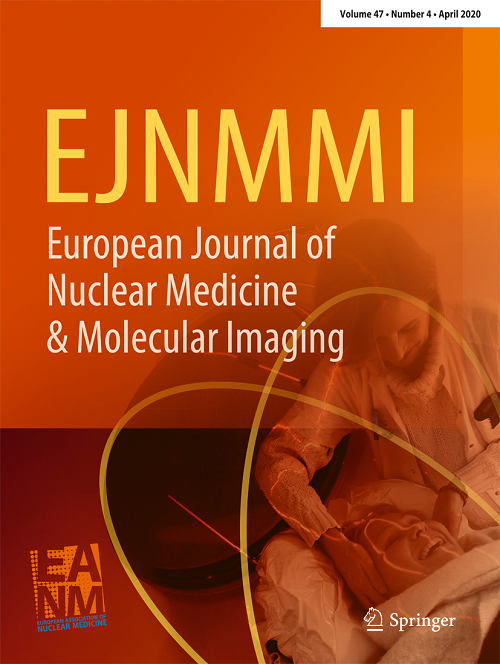Clinical evaluation of deep learning-based CT-free PET reconstruction image: a dual-center study.
IF 7.6
1区 医学
Q1 RADIOLOGY, NUCLEAR MEDICINE & MEDICAL IMAGING
European Journal of Nuclear Medicine and Molecular Imaging
Pub Date : 2025-10-15
DOI:10.1007/s00259-025-07618-z
引用次数: 0
Abstract
PURPOSE Efforts to reduce the radiation burden of PET/CT have driven the increasing development of AI-based CT-less PET imaging techniques. However, comprehensive clinical evaluations of these approaches remain limited. This study aimed to rigorously assess whether deep learning (DL)-based PET reconstruction can eliminate the need for CT-derived attenuation and scatter correction while maintaining image quality sufficient for reliable clinical diagnosis. METHODS In this dual-center retrospective analysis, raw PET/CT data from 359 patients were evaluated across 4 scanners and 4 tracers. Each dataset underwent four reconstruction approaches: (1) CT-based attenuation and scatter correction (CT-ASC, reference standard); (2) conventional 2D-DL; (3) conventional 3D-DL; and (4) our novel Decomposition-based DL algorithm. Diagnostic quality of reconstructed images was systematically assessed via visual scoring (5-point Likert scale), diagnostic accuracy (lesion-based false-positive/negative rates), and semi-quantitative metrics (SUVmax consistency). RESULTS Visual analysis demonstrated the superior performance of Decomposition-based DL compared to conventional 2D-DL and 3D-DL (p < 0.001 for all comparisons). Furthermore, the proposed method exhibited the lowest false-negative and false-positive rates (0.56% false positives with SIEMENS Vision 600; zero rates in other cases). Semi-quantitative analysis showed that although Decomposition-based DL did not consistently yield the lowest mean absolute percentage error values compared to controls, it maintained strong agreement with CT-ASC in most cases. CONCLUSION This dual-center study demonstrates that decomposition-based DL CT-free PET imaging outperforms conventional DL methods, achieving diagnostic accuracy comparable to CT-based attenuation correction in most cases. This clinical evaluation provides valuable insights to guide further methodological development and support clinical translation of CT-free PET imaging.基于深度学习的ct - PET重建图像临床评价:一项双中心研究。
为了减轻PET/CT的辐射负担,基于人工智能的无CT PET成像技术得到了越来越多的发展。然而,对这些方法的全面临床评估仍然有限。本研究旨在严格评估基于深度学习(DL)的PET重建是否可以消除对ct衍生的衰减和散射校正的需要,同时保持足够的图像质量以进行可靠的临床诊断。方法采用双中心回顾性分析,对359例患者的PET/CT原始数据进行4台扫描仪和4种示踪剂的评估。每个数据集进行了四种重建方法:(1)基于ct的衰减和散射校正(CT-ASC,参考标准);(2)常规2D-DL;(3)常规3D-DL;(4)基于分解的深度学习算法。重建图像的诊断质量通过视觉评分(5点李克特量表)、诊断准确性(基于病变的假阳性/阴性率)和半定量指标(SUVmax一致性)进行系统评估。结果视觉分析表明,与传统的2D-DL和3D-DL相比,基于分解的DL具有更好的性能(所有比较p < 0.001)。此外,所提出的方法具有最低的假阴性和假阳性率(在SIEMENS Vision 600中假阳性率为0.56%,在其他情况下为零)。半定量分析显示,尽管与对照组相比,基于分解的DL并没有始终产生最低的平均绝对百分比误差值,但在大多数情况下,它与CT-ASC保持着强烈的一致性。结论:该双中心研究表明,基于分解的DL CT-free PET成像优于传统的DL方法,在大多数情况下,其诊断准确性可与基于ct的衰减校正相媲美。这项临床评估为指导进一步的方法学发展和支持无ct PET成像的临床转化提供了有价值的见解。
本文章由计算机程序翻译,如有差异,请以英文原文为准。
求助全文
约1分钟内获得全文
求助全文
来源期刊
CiteScore
15.60
自引率
9.90%
发文量
392
审稿时长
3 months
期刊介绍:
The European Journal of Nuclear Medicine and Molecular Imaging serves as a platform for the exchange of clinical and scientific information within nuclear medicine and related professions. It welcomes international submissions from professionals involved in the functional, metabolic, and molecular investigation of diseases. The journal's coverage spans physics, dosimetry, radiation biology, radiochemistry, and pharmacy, providing high-quality peer review by experts in the field. Known for highly cited and downloaded articles, it ensures global visibility for research work and is part of the EJNMMI journal family.

 求助内容:
求助内容: 应助结果提醒方式:
应助结果提醒方式:


